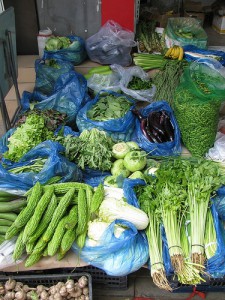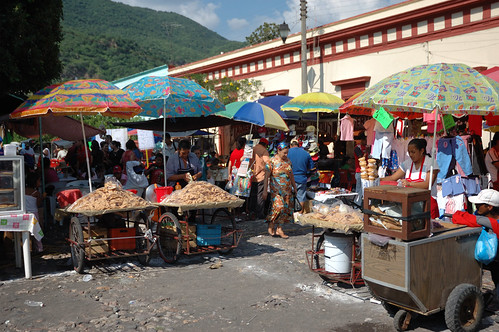- Kew video asks: Why does plant diversity matter? Not to feed people, obviously.
- An entire blog dedicated to the Origin of the Domestic Fowl! Wonder where he stands on the chickens of Chile?
- Benefits of beer sorghum in eastern Kenya.
- Traditional agriculture protects amphibians in Romania shock.
- Seeds for a sustainable future. Conference organized by European Greens for 31 May. Not much notice, I know.
- And another one, on geographical indications, in June.
- How to develop a genetic conservation strategy to safeguard an endangered tree species. Learning module from Bioversity International.
Protecting Chinese agricultural biodiversity products
 So, in retaliation for Europe protecting Roquefort, Stilton cheese and Scottish farmed salmon (sic.), among other agrobiodiversity products, the Chinese have slapped Protected Denominations of Origin (PDO) on Guanxi honey pomelos, Shaanxi apples and Longjing tea and a Protected Geographical Indication (PGI) on Liaxian Mashan yams. 1 Well, no, not really, it was all much more amicable than that. And Dongshan asparagus, Jinxiang garlic, Pinggu peach, Yancheng crayfish and Zhenjiang vinegar are waiting in the wings…
So, in retaliation for Europe protecting Roquefort, Stilton cheese and Scottish farmed salmon (sic.), among other agrobiodiversity products, the Chinese have slapped Protected Denominations of Origin (PDO) on Guanxi honey pomelos, Shaanxi apples and Longjing tea and a Protected Geographical Indication (PGI) on Liaxian Mashan yams. 1 Well, no, not really, it was all much more amicable than that. And Dongshan asparagus, Jinxiang garlic, Pinggu peach, Yancheng crayfish and Zhenjiang vinegar are waiting in the wings…
Veggie genebank gets its seeds out
The University of California Davis (UC Davis) leads an international effort to help developing countries through improved marketing and production of high-value horticultural crops. Established by the United States Agency for International Development (USAID), the Horticulture Collaborative Research Support Program (HortCRSP) supports projects to improve the livelihoods of the world’s poor and builds on their needs highlighted in the Global Horticulture Assessment.
Oh hum, right? Not so fast. One of the projects being supported is this:
Dr. Ricky Bates, Horticulture Department of Penn State University has received a one-year exploratory grant from HortCRSP to look at methodologies for strengthening informal indigenous seed systems in Northern Thailand and Cambodia.
And it gets better. A genebank is involved. My cup runneth over.
The ECHO seed bank partnership is a very important integral part of this project. Dr. Bates states that, “ECHO has been around for awhile. ECHO is located in Ft. Myers Florida and has been around for at least 20 years. They see themselves more or less as an extension service where they are there to resource and support NGOs and people working all around the world with poor farmers. It is a little like an extension system where they provide information and printed material via online or telephone calls to people who may find themselves perhaps in India with World Vision. ECHO is there as a resource for NGOs that do not have an agricultural background. What grew up with the development of ECHO has been the development of a vey innovative seed bank in Ft. Myers Florida where they sort of specialize in tropical fruits and vegetables. They make these seeds available at low cost or no cost to individuals and NGOs working around the globe in development.
Feria del Elote
From CIMMYT’s Flickr feed:
Carts selling tacos made with maize tortillas (traditional Mexican flatbreads) in Jala, Nayarit, on the Pacific coast of Mexico, during the town’s annual two-week Feria del Elote, or maize ear festival. Tortillas are a staple food in Mexico, and are commonly filled to make tacos. For more about maize in Jala, see CIMMYT’s August 2007 e-news story “Pride and pragmatism sustain a giant Mexican maize,” available online.
Photo credit: Eloise Phipps/CIMMYT.
Nibbles: CWR, ICRISAT, Fruits, Maize, Symbionts, Tissue culture, Vegetables, Med diet
- ICARDA saves the world.
- No, ICRISAT saves the world.
- You’re both wrong, it’s CIAT.
- No, wait, maybe it’s CIMMYT. Oh I give up.
- Actually it’s fungi.
- Or maybe tissue culture?
- Surely it can’t be five unknown vegetables?
- Could it be that it’s the Mediterranean diet? And that UNESCO will screw it up for all of us?
